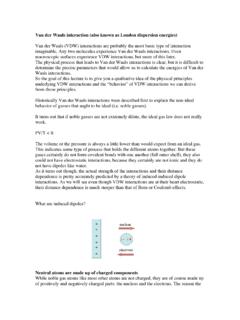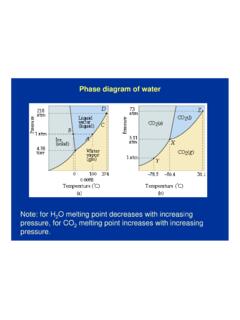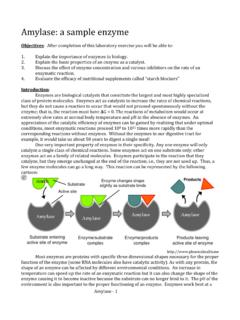Transcription of Hydrogen Bonds - Brandeis
1 Hydrogen BondsHydrogen Bonds have played an incredibly important role in the history of structuralbiology. Both the structure of DNA and of protein a-helices and b-sheets were predictedbased largely on the Hydrogen Bonds these structures form. So understanding hydrogenbonds is clearly important, but much like the hydrophobic effect , Hydrogen Bonds aresurprisingly complex and are not completely understood in every last detail. So take thethings I will tell you with a grain of electrostatic nature of Hydrogen bondsHydrogen Bonds are formed when an electronegative atom approaches a Hydrogen atombound to another electro-negative atom. The most common electro negative atoms inbiochemical systems are oxygen ( ) and nitrogen ( ) while carbon ( ) andhydrogen ( ) are relatively electropositive (the electronegativity values are given onthe Pauling scale, and don t have a direct physical meaning).
2 A gradient inelectronegativity along a covalent bond results in the more electronegative ions pullingshared electrons towards themselves resulting in an electric dipole along the obvious result of this is that the two dipoles will attract one another in the type ofsimple electrostatic dipole-dipole interaction we learned about earlier in class. As youknow this interaction falls off with 1/r3 so the interaction will only matter between nearestneighbors. This dipole-dipole interaction provides much of the source for a hydrogenbond s energy. Lets see how much energy this type of interaction is example in a helix the dipole along the peptide bond is roughly + With interatomic distances on the order of Angstrom and a dielectric constant of6 we get approximately 2kcal/molHydrogen Bonds have a covalent componentAt the same time Hydrogen Bonds tend to form with a geometry in which the hydrogenbond donor, the Hydrogen and the Hydrogen -bond acceptor are arranged in a straight electrostatic terms this arrangement is clearly less favorable than an arrangement inwhich the two dipoles are folded over on top of one another to bring both positivecharge centers directly into contact with the two negative charge centers.
3 This is clearlynot what is happening in the case of Hydrogen Bonds , so there has to be anothercomponent to Hydrogen bonding beyond pure additional contribution is covalent in nature. What is the evidence for this covalentnature? First, neutron scattering data shows that the distance between the nuclei of thehydrogen bond acceptor and the Hydrogen itself can be as short as , well belowthe sum of the atomic radii ( for Hydrogen and ~ for oxygen and nitrogen).You know that the Lennard-Jones potential rises with 1/r12 if we get closer than the Vander Vaals radii. The only way these atoms can get closer to one another is if they areinvolved in a covalent , Quantum mechanical calculations show that the free electron pairs found onnitrogen and oxygen are delocalized around the Hydrogen nucleus similar to the wayelectrons are shared by bonded atoms in a normal covalent bond.
4 This covalent component of the interaction is strongly orientation dependent, in order to get thiscovalent interaction the orbital with the free electron pairs of the Hydrogen bond acceptorhave to be aligned quite well just like the geometry of covalent bonding is is a graph showing the results of a quantum mechanical simulation of the bondingstrength between two water molecules as a function of the angle between the two interaction energy is clearly favorable if the free electron pairs of the acceptormolecule are pointing towards the donor but become equally unfavorable governing Hydrogen bonding what does our basic physical picture of the Hydrogen bond tell us about the relativestrength of different Hydrogen Bonds ? From the equation for the dipole-dipole interactionwe see that the interaction energy depends on the square of the partial charges.
5 So if weincrease the polarization between the atoms involved in the Hydrogen bond, the hydrogenbond should become much stronger. Fluorine is the most electronegative element ( the Pauling scale) and because of this fluorine forms some of the strongest hydrogenbonds. For example, the Hydrogen bond between HF and a fluoride ion (FH F-) iscalculated to be 40 kcal/mol in the gas proteins some of the strongest Hydrogen Bonds are salt bridges that involve chargedatoms. Salt bridges typically contribute energies of 3-4 kcal/mol and their contributioncan be as high as 8 kcal/mol if the salt bridges are completely buried in a protein reason for the increase in the interaction strength when the salt bridge is buriedinside a protein s interior should be clear to you; electrostatic interactions are inverselyproportional to the dielectric constant of the surrounding way in which we can boost the strength of a Hydrogen bond is by using thepolarizing effect of one Hydrogen bond to increase the strength of the next.
6 This effecthas been studied extensively in of the Hydrogen bond results in shift of electron density, indicated by redarrows, so that the charge on the Hydrogen -bond donor s oxygen atom increases and thecharge on the acceptor s Hydrogen atom decreases making both of them more attractivehydrogen bonding partners for the next water molecule. The result of this effect is theenergy of adding successive water molecules to an existing cluster of Hydrogen bondedwater molecules increases with the size of the example of this mechanism of Hydrogen Bonds that stabilize additional hydrogenbonds are the mutually stabilizing Hydrogen Bonds in DNA. Both AT and GC basepairsform one set of such Hydrogen Bonds . Forming one Hydrogen bond polarizes the atomsinvolved in the second Hydrogen bond, making that bond stronger, which in turn furtherpolarizes and stabilizes the first Hydrogen final example of this mechanism of Hydrogen bond stabilization is the formation ofhelices.
7 The alignment of all the peptide bond dipoles results in a net dipole of the helix,favoring the incorporation of additional residues into the contribution to protein stabilityHydrogen Bonds in which everything is just perfect can be incredibly strongSo if we take a peptide made out of amino acids that favor helix formation (leucine, glu,ala etc. what do you think is the conformation they will adopt in water. Of course analpha helix you might say, but surprisingly they don t! Virtually none of the randompeptides will adopt alpha helices, much less beta sheets. The stability of these secondarystructures is very close to zero (at best) and typically formation of secondary structure isdisfavored. There is of course an entropic component, but even if we take that componentout. (We can determine the enthalpic component for the formation of Hydrogen Bonds inwater from heat capacity measurements).)
8 This enthalpy of Hydrogen bond formation isstill very close to could be the reason? Right our solvent is water, and water is an extremely goodacceptor and donator of Hydrogen Bonds . So if we have a peptide that is unfolded insolution we can make a lot of geometrically perfect Hydrogen Bonds with a very polarizedmolecule, water. So the reason that Hydrogen Bonds do not have a net stabilizing effecton protein structure lies in the fact that in order to form peptide-peptide Hydrogen bondswe need to disrupt another set of very favorable Hydrogen Bonds , those the peptide canmake with reason we still see so many Hydrogen Bonds in protein structures is that we need tobury the backbone of our protein in order to form a hydrophobic core. Placing the dipolesthat form the Hydrogen Bonds into this hydrophobic environment is unfavorable, but wedo not have a choice.
9 Once in the hydrophobic core, the energy of interaction between thedifferent Hydrogen bonding partners increases (due to the low dielectric constant) so theinteractions become quite strong making the protein quite rigid. As a matter of fact itenergetically very unfavorable not to form a Hydrogen the overall effect of Hydrogen Bonds in proteins is that of providing structural rigidity,not ~2 kcal we loose if we do not form a Hydrogen bond means that the probability ofseeing a Hydrogen bond broken is pnotformedpformed=e-2kcal/molRT= other words we would expect that in a 30 kD protein which has around 200 residuesburied in the hydrophobic core only approximately 7 ( ) would not formhydrogen is pretty close to what is observed in a survey of the protein structural Hydrogen Bonds in protein interior are very rare and if they are observed,they often are involved in substrate binding or play some catalytic Rules of Hydrogen bondingRULE 1: The greater the charges, the stronger the Hydrogen 2.
10 The shorter the distance the stronger the Hydrogen bond length is traditionally measured by the distance between the donor atomand the acceptor atom. By definition we say a Hydrogen bond occurs if the distancebetween the donor and the acceptor atoms is shorter than the sum of the atomic radius ofthe acceptor atom (~ ), the atomic radius of the Hydrogen ( ) and bond lengthbetween the donor atom and the Hydrogen (~1 ). So the longest Hydrogen Bonds are~ . Anything longer would be considered a pure dipole-dipole interaction. Goodhydrogen Bonds have a distance of ~ and some ultra-short Hydrogen Bonds havebeen reported with donor to acceptor distances of 2 .RULE 3: Bonding angles matter, the more ideal the bonding angle, the stronger thehydrogen bond. This is an indication that Hydrogen Bonds have a partial covalentcharacter.












